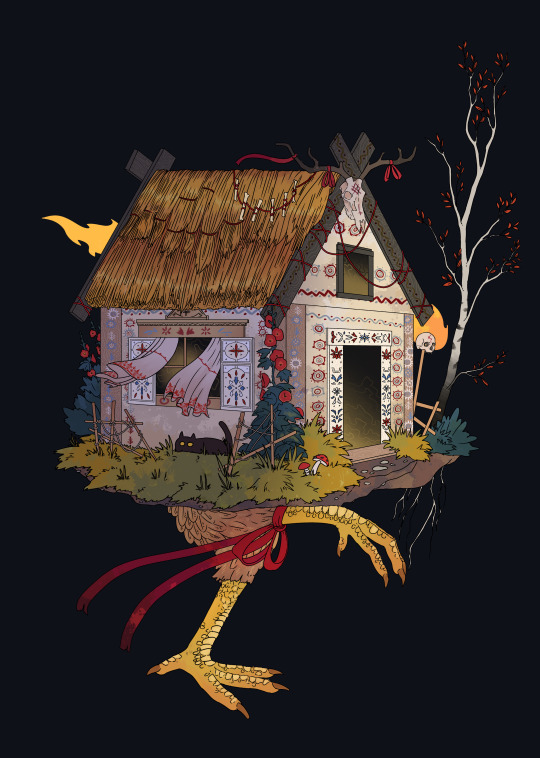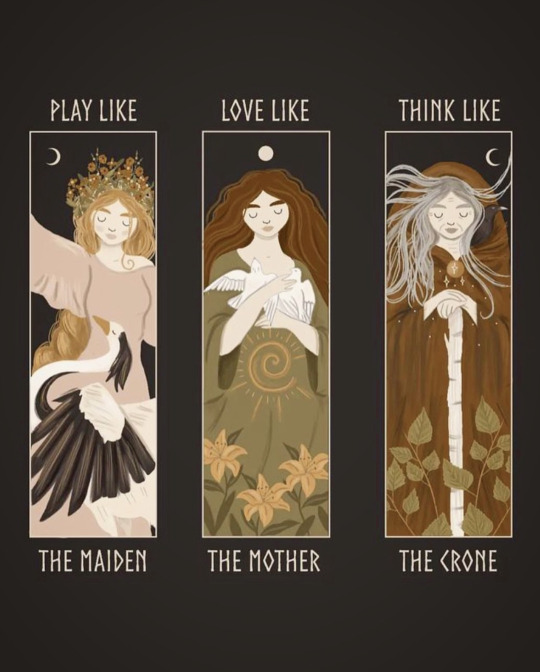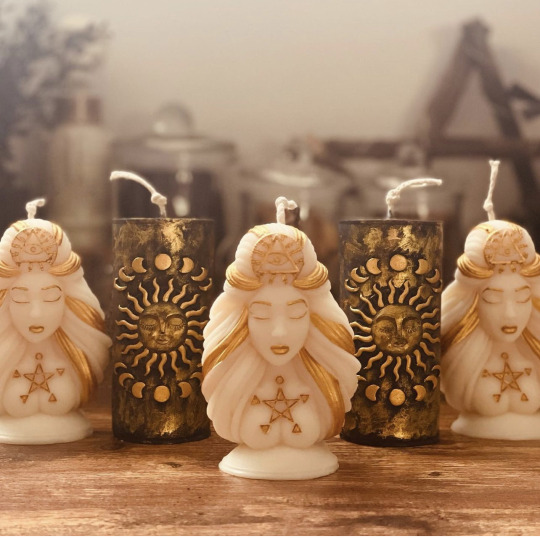#pagan crone
Explore tagged Tumblr posts
Text

I forgot to post it but back around summer I drew Baba Jaga's hut. Try to find the cat!
#folklore#folklore art#baba yaga#fairytales#slavic#slavic art#slavic folklore#cozy#cozy cottage#maiden mother crone#wiccan#wicca#witch#pagan witch#witchy art#witchcraft
8K notes
·
View notes
Text
𝕸𝖔𝖙𝖍𝖊𝖗, 𝕸𝖆𝖎𝖉𝖊𝖓 & 𝕮𝖗𝖔𝖓𝖊

First, we have a crescent moon that is in a growing stage. In the center, there is a circle representing the full moon. Last but not least, the crescent denotes the diminishing moon.
Triple Moon is considered to be symbolic of all things divine feminine power – from intuition to creative energy, and wisdom. It indicates the three life stages of a woman.
The waning moon symbolizes the Maiden through innocence, youth, new life, starts, rebirth, excitement, witchcraft, and growth.
The full moon represents the Mother: fulfillment, fertility, ripeness, potency, understanding, caring, security, and authority.
The waxing moon symbolizes the Crone: serenity, maturity, knowledge, experience, knowledge, wisdom, fulfillment, death and rebirth. In its whole, the symbol is associated with the eternal cycle of birth, life, and rebirth.
Sometimes called the Triple Goddess symbol, the triple moon is frequently seen on the crowns or headpieces worn by the High Priestesses.
Each aspect within the Triple Goddess is associated with particular seasons and other natural phenomena, as well as human characteristics and elements of life on Earth. These associations can be used to call on the appropriate aspect of the Goddess during magical work, ritual worship, and prayer.
The Maiden is represented by the waxing moon and associated with the start of the growing cycle of late winter and springtime. The Wheel of the Year sabbats Imbolc, Ostara and Beltane are associated with the Maiden phase of the Triple Goddess. The Maiden represents beauty, fresh potential and new life. In human beings, she is associated with the qualities of innocence, youth, self-confidence, intelligence and independence, and with activities relating to exploration, discovery, self-expression, and creativity. Goddesses who represent the Maiden include the Greek goddesses Persephone and Artemis, the Celtic Rhiannon, and/or the Nordic Freya, among others.
The Mother phase of life is represented by the full moon- the fullest part of your life. In the Wheel of the Year it is associated with the harvests of Lughnasadh and Mabon. In the human realm, she is associated with nurturing, responsibility, adulthood and the fullness of life. As the giver of life, she is the aspect most associated with manifestation. Goddesses who represent the Mother include the Greek Demeter and Selene, the Roman Ceres, and the Celtic Danu and Badb.
The Crone phase of life is represented by the waning moon- when the cycle comes to an end and a new beginning starts. The Crone is full of wisdom and life experience. In the Wheel of the Year she is associated with Samhain and Yule, when the days shorten and the growing season officially ends. The Crone is the wise elder aspect of the Goddess, and governs aging and endings, death and rebirth, and past lives, as well as transformations, visions, prophecy, and guidance. Although feared as an archetype for millennia, she is the one who reminds us that death is part of the life cycle, just as the Moon's dark phase precedes the New Moon. The Crone is often represented by goddesses associated with death and the underworld, such as the Greek Hecate, the Russian Baba Yaga, and the Celtic Morrigan and Cailleach Bear.
The Triple Goddess is indeed a diverse and complex expression of the divine feminine. For those who worship her, she provides constant opportunities to learn and grow through connecting to her three aspects. Whether you recognize ancient goddesses as aspects of the Triple Goddess, or simply honor the Maiden, Mother, and Crone archetypes, you can make a conscious effort to align your worship with the cycles of the Moon for an even deeper, more rewarding spiritual connection.
#spirituality#divination#witchblr#tarot#witch#witchcraft#free tarot readings#high priestess house#astrology#witch community#wiccablr#wiccan#wicca#pagan wicca#triple goddess#the maiden#the mother#the crone#feminine energy#divine feminine#eclectic witch#pagan witch#witchy vibes#witchcore#witchy#witches#witch stuff#witches of tumblr
228 notes
·
View notes
Text

🎨anetteprs
#maiden mother crone#tripple goddess#witchblr#witches of tumblr#witchcraft#wicca#pagan#witchy things#witchy#magick#baby witch#witchcore#witch community#witchy woman
1K notes
·
View notes
Text


Apostle (2018)
#apostle movie#folk horror#horror movies#horror movie gif#british horror#cult horror#cultist#earth goddess#pagan deities#fear#dark goddess#crone#psychotronic film#natural horror#psychological horror#survival horror#horror films#horror#scary#creepy
116 notes
·
View notes
Text

If we were to have a God hold dominion of a certain time of year, I would say this time of year always feels like Hecate season to me. Goddess of witchcraft, ghosts, necromancy and a myriad of other things that go bump in the night, she is the queen of Halloween in many respects. While I appreciate the more traditional depictions, I wanted to do something that harkened more to her creature of the night feel. While also still holding some of the traditional totemic symbology. ( this is NOT AI generated)
#Hecate#goddess#greek mythology#roman mythology#witchcraft#fantasy art#pagan#halloween#mythology#character design#creature design#goth#macabre#happy halloween#illustration#horror#paganism#goth girl#trinity#crone
311 notes
·
View notes
Text
Surprise! We're on hiatus while Greg and Dana are on tour, but to give you some Haunted Objects Podcast in the meantime and to celebrate some news about "The Unbinding", our live special on The Curse of the Catskills Crone just dropped!
youtube
While hiking off the beaten path in New York's Catskill Mountains, two hikers stumbled upon a disturbing statue hidden inside a cave. Then, all hell broke loose.
To celebrate Tubi's free-to-watch debut of our scary-as-hell documentary "The Unbinding", join us for this special LIVE episode of The Haunted Objects Podcast! Featuring previously unreleased footage, interviews with the cast and crew, and more surprises, this episode is stuffed with exclusive insight into the making of Planet Weird's first feature-length film... and our most frightening paranormal investigation yet. Plus, the Brotherhood of Magicians returns with a limited edition merch drop set to disappear faster than you can say "abracadabra".
Time to lace up your hiking boots and prepare to suffer a witch, because we're heading into the mountains to break the curse of the Catskills Crone!
Watch "The Unbinding" for free on Tubi:
#planet weird#haunted objects podcast#newkirk museum of the paranormal#the unbinding#witchcraft#high strangeness#paranormal#dana newkirk#greg newkirk#hellier#horror documentary#documentary#the crone#horror podcast#podcasts#podcast#podcasting#witchblr#pagan#paganism#tubi#free on tubi#Youtube
39 notes
·
View notes
Text
Samhain Ritual 2024 Excerpt - The Story & History of Samhain
While I'm not leading the Samhain ritual, my coven/circle is leading, I am helping with some sections of it! Notably, I wrote the section about the history of Samhain and how we celebrate it today. I thought I'd share it here like I've done with my other scripts, so I hope y'all enjoy it! (Note: I am not a Celtic pagan, so please excuse me if any information is wrong! I've included the bibliography at the end.)
DO NOT INTERACT: TE/RFS, TE/HMS, SW/ERFS, TRAN/SMEDS, TRUS/CUM, TRANSPHOBIC, HOMOPHOBIC, EXCLUSIONISTS, CONSERVATIVE, NAZI, TRADWIVES, ANTI-BLM, ANTI-ASIAN, XENOPHOBIC, ABLEIST, ANTI-POP CULTURE PAGANISM

Samhain is the final harvest before winter when the veil between the physical and spirit worlds is thinnest. Celebrated alongside Halloween, Dia de los Muertos, and All Saint’s Day, Samhain marks the end and beginning of the Wheel of the Year as we enter the darkest half of the year.
Samhain, as we know it to be currently, originates from ancient Celtic traditions. It was celebrated in the British Isles as the “night between years,” when the dead walked among mortals. The most important of the four Celtic festivals was a time to take stock of crops before the frost and honor the ancestors.
Many of our modern Halloween traditions come from old Celtic traditions. The aos sí (ace SHE), fairy-like spirits, were left food and drink outside to avoid their mischief, such as killing livestock during the winter. People went door-to-door in costumes to blend in with the aos sí and collected offerings, a predecessor to trick-or-treating. Rather than pumpkins, turnips were carved with faces to symbolize the spirits crossing over and ward off malevolent ones.
There were several Celtic deities and entities who were and still are associated with Samhain. The Pooka, a shapeshifting Irish figure often depicted as a dark horse with fiery eyes, roamed the countryside, causing mayhem, and was a bringer of both good and bad fortune. Cerridwen, the cauldron-keeper Welsh triple goddess of the underworld, and The Morrigan, the Irish triple goddess of war, death, and fate, were both commonly associated with Samhain due to their associations with the cycles of life, death, and rebirth.
Samhain has become a tradition among modern pagans and is included in the Wiccan Wheel of the Year. The most important of the four greater Sabbats it’s a time to reconnect with ancestors, such as decorating altars with candles and mementos of loved ones who have passed. Divination, a typical ancient Celtic Samhain practice, is also a modern activity. Samhain is also an excellent time for shadow work and exploring your unconscious self.
In modern Wiccan practices, Samhain is associated with the Crone, the final of the Triple Goddesses. She’s one to go to for advice and teaches us that sometimes we need to let go to move on. The God of Samhain, The Horned One, is the animal that dies so we may eat and survive the winter. Gods and Goddesses not from Celtic lore but still associated with Samhain include Persephone, Hades, and Hecate from Hellenic tradition, Anubis and Osiris from Kemetic mythology, and Freya, Hel, and Odin from the Norse path.
Take this time to connect with the past, present, and future as the Wheel of the Year turns once more.
Bibliography
Gavin, Sophie. “Samhain - Celtic Festival of Spirits and Transformation.” Celtic Fusion ~ Folklore Clothing, Celtic Fusion ~ Folklore Clothing, 6 Mar. 2024, celticfusiondesign.com/blog/samhain-celebrating-the-celtic-festival-of-spirits-and-transformation.
Kiernan, Anjou, and Leslie Olson. The Ultimate Guide to the Witch’s Wheel of the Year: Rituals, Spells & Practices for Magical Sabbats, Holidays & Celebrations. Fair Winds, 2021.
“Origins in Samhain.” 13 Things, www.brown.edu/Departments/Joukowsky_Institute/courses/13things/7448.html. Accessed 28 Oct. 2024.
“Samhain (Samain) - The Celtic Roots of Halloween.” Newgrange.Com, www.newgrange.com/samhain.htm#:~:text=In%20Celtic%20Ireland%20about%202%2C000,allowing%20spirits%20to%20pass%20through. Accessed 28 Oct. 2024.
“Samhain.” Wikipedia, Wikimedia Foundation, 28 Oct. 2024, en.wikipedia.org/wiki/Samhain.
“Samhain: 13 Facts about Halloween’s Celtic Roots.” OghamArt, 31 Oct. 2022, oghamart.com/blogs/news/samhain-halloween-celtic-roots.
Wigington, Patti. “Ritual to Honor the God and Goddess at Samhain.” Learn Religions, Learn Religions, 8 Mar. 2018, www.learnreligions.com/celebrate-the-god-goddess-at-samhain-2562703#:~:text=In%20some%20Wiccan%20traditions%2C%20by,in%20order%20to%20move%20on.
#witch#witchcraft#witchblr#sabbat#samhain#wheel of the year#samhain 2024#celtic#celtic paganism#gaelic#gaelic paganism#pooka#cerridwen#the morrigan#aos si#wicca#wiccan#triple goddess#the crone#the horned god#persephone#hades#hecate#anubis#osiris#freya#hel#odin#pagan#paganism
30 notes
·
View notes
Note
Also: Hekate is never mentioned as the Maiden Mither Crone archetype. She is a “triple” goddess but her three forms are Selene, Hekate, Artemis. (Sometimes Persephone is swapped for either Selene or Artemis). Like I swear when I first started dabbling into this whole thing I actually put my own knowledge from my own damn culture in the back burner and took that Neo-Pagan shit for granted. Always do research!!!!!
Oh yeah! That's a great example of an ancient goddess getting something totally modern projected onto her.
97 notes
·
View notes
Text
i love being an aphrodite devotee as well as a cosmetologist... she is in everything i do!! she blesses me everyday with so many gifts! she is the smile on every client's face, the confidence in my movements, the beauty that clothes me and the Gift she has given me to be able to impart confidence and beauty into other woman... when i work, i truly feel like a vessel for her love and abundance. i am so grateful for all she has given me 💕
#aphrodite#aphrodite devotee#aphrodite devotion#wiccan#witches of tumblr#pagan#hellenic pagan#maiden mother crone#cosmetology#hairstyle#cute nails#makeup#skincare
86 notes
·
View notes
Text
Me early in my practice: I really don't trust myself can yall flip out the cards very obviously so I know what you're saying?
Me now a seasoned witch: *half the deck explodes out for me while doing someone else's reading* Please stop I'm doing someone else's reading rn!! *throws out cards while I'm putting it away* ..... Thank you but the reading is done!
#Great thing that helps with my practice but boy is it funny when it happens when I don't need it XD#beginner witch#crone#witchblr#witch community#witch#tarot#pagan#osbe
10 notes
·
View notes
Text

Thought i'd share my altar for Hecate too.
Hail Hecate,
Queen of All Witches.
Protector of the broken,
Torchbearing guide to the lost.
Hail the Dark Mother,
Hail the Crone.
#hecate devotee#hecate#paganism#greek mythology#goddess#crone#dark mother#queen of all witches#witchblr#witchcore#witchcraft#chaos witch#deity work
11 notes
·
View notes
Text
A frosty, beautiful morning as a fitting backdrop for my druid Imbolc ritual. The Maiden awakens, let us greet Her rising! A Blessed Imbolc to all, and may the Gods be with us ever.


#norse pagan#eclectic pagan#celtic pagan#pagan#pagan community#pagan wicca#pagan witch#paganism#pagans of tumblr#writers on tumblr#imbolc#druidry#druidism#druid#heathen#norse heathen#germanic heathen#spring#maiden mother crone
9 notes
·
View notes
Text

📷 flyingbatsemporium
#tripple goddess#goddess altar#triple goddess#witchblr#witches of tumblr#witchcraft#wicca#pagan#witchy things#witchy#magick#candle magick#candle magic#mother maiden crone#sun and moon#moon and sun
202 notes
·
View notes
Text

Grandmother Mountain
ig@hrafnsunnaart
#mountain#heathen#art#spiritual#grandmother#surreal art#pagan#crone#aesthetic#sketch#nature#witchcraft#heathenism#witchblr
97 notes
·
View notes
Text

Welcome to October. As the temperature cools and the line between our world and the spirit world blurs, we edge ever closer to Samhain and the turning of the Wheel.
14 notes
·
View notes
Text
I am aging and it is beautiful
I will become the Crone of my wildest dreams
#paganism#pagan#pagan witch#norse paganism#norse pagan witch#heathenism#crone#maiden mother crone#aging#aging gracefully#basil blabs
11 notes
·
View notes